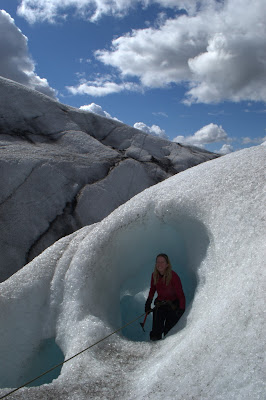It would
be a bit of an understatement to say that the South of Iceland is an exciting
place. It’s home to the largest glacier in the country, Vatnajökull. It´s where the Eyjafjallajökull
(easy for us to say) eruption that stranded flight passengers all over the
world in 2010 took place. And it’s even possible to see the newest island in the
world. We decided to take a trip there and do some adventuring of our own.
We’re
getting quite used to seeing amazing sights, but were once again wowed when we
visited Jökulsárlón glacial lagoon.
One
of the most beautiful sights was on the opposite side of the road, where the
icebergs wash up on a black beach after the tide pulls them out to sea.
And a smaller lagoon nearby was pretty special too.
Icelandic Mountain Guides gave us some crampons and took us on a guided walk on the Vatnajökull glacier.
We walked between the Eyjafjallajökull and Mýrdalsjökull
ice caps and over the new craters Magni and Móði, which were formed during the
2010 eruption and are still steaming. We heard that some hikers, who stood
still for too long last year, set their boots on fire with the heat. Luckily the
lava has cooled down a bit since then and we managed to complete the 25km hike
fully clothed.
We
got a little taste of Iceland´s Highlands with some spectacular views on the
way into Þórsmðrk and particularly
enjoyed making it across Heljarkambur, a narrow 50m traverse with a
vertical rock face rising on one side and a steep snowfield dropping 75m on the
other.
The
hike took us about 10 hours including a dinner stop between the glaciers at Fimmvörðuháls,
where there is a hut that hikers can use to take a break or even stay the night
in. We completed the hike, camping at Húsadalur in Þórsmðrk, adding a
couple of kilometers and river crossings to the route. The next morning we took
the bus back to Skógar and enjoyed some more river crossings that were a bit
more fun without the cold wet feet.
Having
learned all about the Vestmannaeyjar at the Volcano House cinema in Reykjavik we were really looking forward to visiting it’s only populated
island, Heimaey, especially Louise who didn´t have a nap during the films.
 |
| Before and after, a photo of a photo of the eruption |
 |
| Signs above the lava, remember the streets below |
We
camped in an extinct crater, which we later found out on a boat trip around the
island was also next to a giant
elephant…
The
boat trip also gave us the opportunity to see the newest island in the world,
Surtsey, which was created in a volcanic eruption in 1963. Tourists will never
get to visit Surtsey, so this is probably the best view we’ll get.
On
our first night, and continuing our midnight adventure theme, we climbed to the
top of Stóra-klif assisted by some ropes and chains that definitely wouldn’t
pass the health and safety regulations back home. The views were amazing and we
even met a puffin.
That
wasn’t the only puffin we met on Heimaey. At the island’s Aquarium and Museum of Natural History we got
introduced to Toti, a two year old rescue puffin, who was taking a bath in the
back of the museum. And if that wasn’t exciting enough, when Rob went to
collect his backpack, kindly kept in the staff office for us, he was startled
by a baby puffin hiding behind it – very cute.
We´re not sure if it´s the nicest beach in the world as stated by our Lonely Planet, but another highlight of our trip was walking barefoot on a beautiful black beach in Vic.
We´re not sure if it´s the nicest beach in the world as stated by our Lonely Planet, but another highlight of our trip was walking barefoot on a beautiful black beach in Vic.
Bless bless, xxx



























